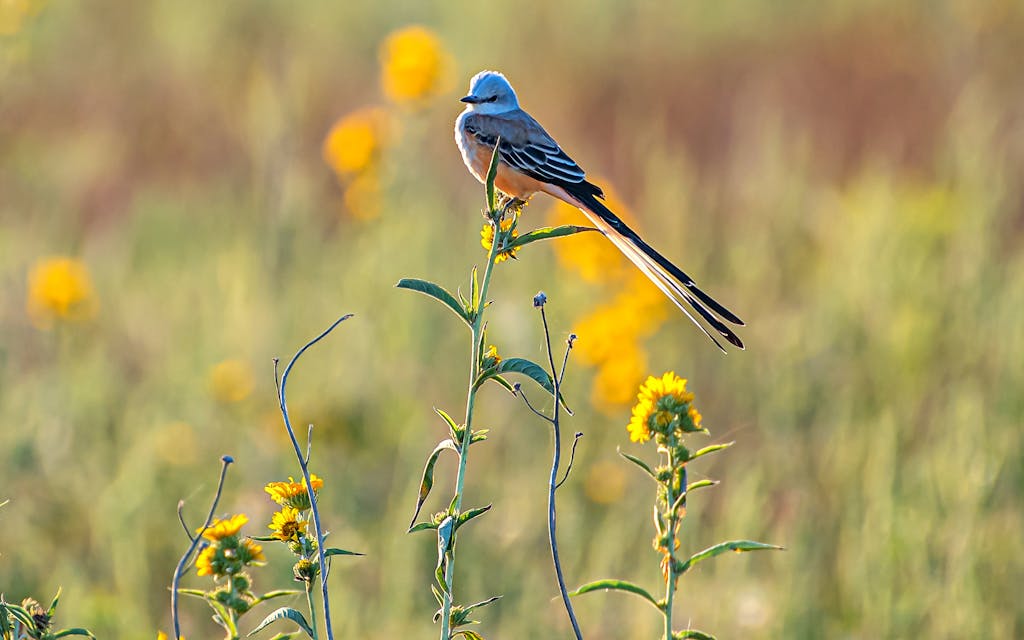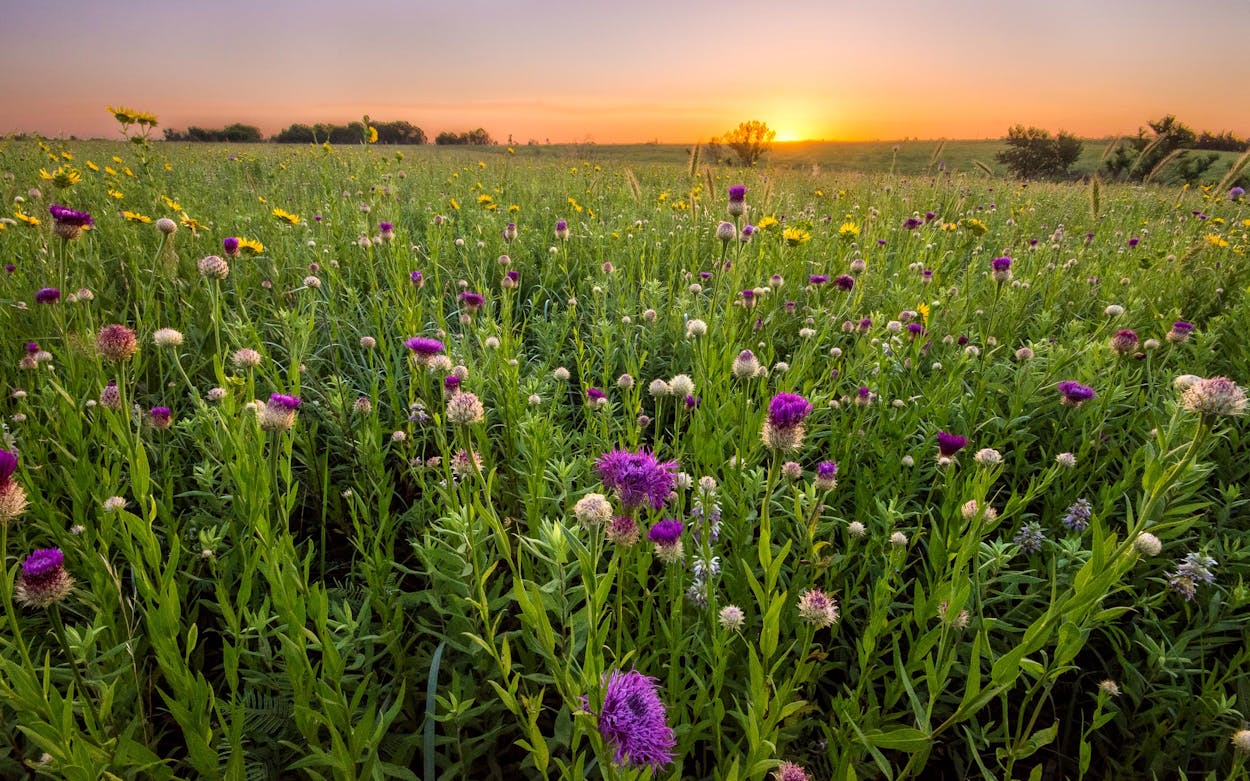On a blustery morning in April, the gently rolling green hills of Clymer Meadow Preserve look vaguely like the scene of an Easter egg hunt. Three dozen visitors scatter across the lush terrain at this nearly 1,500-acre expanse near Celeste, about sixty miles northeast of Dallas. Everyone pauses periodically to crouch low and peer into a blanket of broadleaf plants, flowers, and grasses. Some use their phones to snap photos; others just admire the greenery.
But they’re not after jelly beans or chocolate rabbits. Like me, they’ve come to the preserve, most of which was acquired in 1986 by the Nature Conservancy in Texas, for a public wildflower tour. Nature Conservancy lands in the state aren’t usually open to the public, but this event is one of several open days that the nonprofit regularly holds.
Clymer Meadow is special because it’s a rare remnant of untouched blackland prairie. Our three-and-a-half-hour walk offers a glimpse of what this part of Texas looked like before shopping malls, highways, and gas stations. The soil on part of this preserve has never been plowed.
“It’s incredibly rare because there’s so very little blackland prairie left,” says Brandon Belcher, the Nature Conservancy’s North Texas preserves manager, who is leading the day’s tour. “What we’re looking at is what we think it looked like a thousand years ago. It’s remained unchanged. There’s culture and heritage and history tied to it. It’s got broad biodiversity, and we have so much to learn from the land.”
The ground is uneven, with pockmarks and hidden depressions in the soil that make for slow going. It feels like we’re walking in mashed potatoes that were spread on the ground, left to partially harden, then overgrown with myriad kinds of green plants. As we make a big, wandering loop, Belcher explains the importance of this pristine land. “Because this space was not plowed, it retained that magic,” he says.
Here’s what I notice so far: scenery so green I feel like I’m swimming in a bowl of lime Jell-O. Eastern kingbirds dipping and swirling, then disappearing into the shamrock-colored backdrop. Crawfish holes, bored into the soil near the creek like miniature groundhog tunnels. Vultures, riding currents high overhead. And little clouds of insects rising from the sea of plants through which I’m wading.
“To understand the prairie, you have to get into the prairie,” Belcher says. “You have to walk in it and hear it and smell it and touch it.” He squats on the ground to take a closer look. “In just this space in front of me we have a huge diversity of species.” He points out phlox, prairie celestial, Indian plantain, sensitive briar, and canary grass. This summer, he says, bluestem, Indiangrass, gamagrass, and switchgrass will predominate.
The tallgrass prairie once stretched from the Texas Gulf Coast to Canada. Fire occurred naturally, and bison, deer, and pronghorn roamed through, periodically clearing the land of vegetation and stomping hoof-size divots in the ground.
“They would decimate the property,” Belcher says. “But the prairies are really a disturbance-maintenance system. They need a regular disturbance to reset the system to keep them healthy.” Indigenous peoples have known this for thousands of years, and they long used prescribed burns to manage the prairie.

Settlement by Anglos began here in about 1850. After the Civil War, farmers started plowing fields and planting seeds. Eventually settlers sectioned off fields and broke the vast stretches of grassland into chunks. Most land in this area was plowed repeatedly, and over time native plants were lost. “Of course, we need some agriculture and it’s important to have working lands, but because blackland prairie was so productive, just about everything that could be converted to agriculture was converted,” Belcher says.
But when land is plowed, it changes. “When we break apart the soil, things are lost that are difficult to capture. Carbon is one of those things,” he says. “By changing the soil structure mechanically, it changes the way it cycles nutrients, and the way it captures and holds water.”
Today the temperate grasslands are among the most imperiled ecosystems on the planet. The blackland prairie of Texas, a subset of the larger swath of prairie land, has slowly disappeared, eaten up by farming and development. What remains is at risk. As land prices rise, landowners are incentivized to sell or develop their properties. “Development drives changes in the landscape—more lights, more neighbors, more sound and traffic every year,” Belcher says.
This piece is special. No plow ever turned its soil. The meadow instead was used as forage for draft animals that worked the surrounding land. “When everything else was planted with cotton, this piece was important to provide for the animals,” Belcher says.
Farmers also cut hay—a generic term for the array of plants that grow naturally—to keep the land profitable. “It produces a fantastic hay. Forage from native meadow is very nutritious,” Belcher says. “Eventually it became a source of pride, because nobody had prairie left in their possession.”
The preserve is named for pioneer Jim Clymer, who bought land in the 1850s. The Nature Conservancy acquired most of the property for the 1,475-acre preserve, which also includes chunks of land owned by private landowners, in 1986. Of that, 750 acres have never been plowed.
“The biodiversity is very high in these remnant spaces,” says Belcher, citing the vast number of birds, insects, mammals, and reptiles and amphibians that live on Clymer Meadow. “We’re able to support some specialty species that other properties in the region cannot.”
Today crews maintain the land through prescribed burns. They’ve also removed invasive trees and plants to help native species thrive, including wildflowers such as purple Indian paintbrush and prairie clover. Each year volunteers help collect seeds from the land, and these are later used to help restore other Nature Conservancy lands.
We ramble on, wading through a sea of knee-high plants still damp from the previous night’s thunderstorms. Everything looks fresh: the purple-pink, five-petaled blooms of the prairie phlox; the tall yellow clusters of prairie parsley; the stems of wild indigo that remind me of bluebonnets; the dramatic stalks of white prairie larkspur; and my favorite, the brush-shaped fuchsia bursts called purple paintbrush. A few echinacea are starting to bloom, their flowers the color of Dubble Bubble chewing gum.

The palette changes with the seasons. In a few weeks, bright yellow rosinweed and big purple basket flowers will take over. “We’ll have hundreds and hundreds and hundreds,” Belcher says. “They’ll cover the hillsides.” Come June, the Illinois bundleflower, prairie clover, and prairie rose will step up to the stage.
Want to see for yourself? More public events are planned at the preserve this spring. Clymer Meadow’s thirty-seventh Spring Wildflower Tour is scheduled for 9 a.m. on May 20, and a Basketflower Tour is set for 8 a.m. on June 3. Another public tour will take place this fall. The events are free, but an RSVP is required.
Clymer Meadow isn’t the only place where you can explore Nature Conservancy lands across the state. The nonprofit protects nearly one million acres at 37 nature preserves and other sites in Texas. A few of the preserves are open daily, while others hold occasional public access days. To learn more about the Nature Conservancy’s work in Texas, go here. For information about events at specific sites, click on individual sites here. We’ve rounded up a few of our favorites below.
Where to Explore Nature Conservancy Land in Texas
In West Texas, Mount Livermore, the fourth-highest peak in Texas, rises from the Davis Mountains Preserve. The preserve will open for camping, hiking, biking, picnics, birding, and other outdoor activities June 2–4, August 25–27, and October 20–22. (The nearby Madera Canyon Trail, separate from the preserve, is open to the public daily.)
The Eckert James River Bat Cave Preserve, near Mason in the Texas Hill Country, is home to a colony of about four million female Mexican free-tailed bats that live, give birth, and raise their pups there between May and September. The preserve will open later this month for bat watching on specified evenings during the season.
Lennox Woods Preserve, northeast of Dallas, is home to some of the state’s most pristine old-growth forests. A 1.5-mile trail that is open daily weaves through one of the few remaining stands of virgin timber in Texas. And at Roy E. Larsen Sandyland Sanctuary, north of Beaumont, visitors can see one of the state’s last remaining longleaf pine forests. It opens daily for hiking, exploring, and canoeing.
Love Creek Preserve, in the Bandera Canyonlands, northwest of San Antonio, and the coastal Clive Runnells Family Mad Island Marsh Preserve, known for its spectacular spring bird migration, also open occasionally for volunteer work days and special events, as do Barton Creek Habitat Preserve, Texas City Prairie Preserve, Independence Creek Preserve, and Marathon Grasslands Preserve. For more information about access to various sites, go to the Nature Conservancy’s website.






